This is a King Regula RM, a 35mm rangefinder camera made by Regula-Werk King KG in Bad Liebenzell, Germany between 1956 and 1959. The Regula RM is part of the King Regula III-series of cameras which contained a total of nine separate models, all with slightly different features. The distinct features of the Regula RM are that it has a coupled rangefinder, fixed lens, and an uncoupled Bewi exposure meter. The camera was made with four different lenses, one each from Enna, Rodenstock, Steinheil, and Zeiss. It is an attractive and well made camera from a manufacturer not well known to western camera collectors.
Film Type: 135 (35mm)
Lens: 45mm f/2.8 Rodenstock-Trinar coated 3-elements in 2-groups
Focus: 3 feet to Infinity
Viewfinder: Coincident Image Coupled Rangefinder
Shutter: Prontor SVS Leaf
Speeds: B, 1 – 1/300 seconds
Exposure Meter: Uncoupled Bewi Selenium Cell
Battery: None
Flash Mount: Cold shoe and M and X Flash Sync
Other Features: Self-Timer
Weight: 549 grams
Manual (similar model): http://www.urmonas.net/manuals/regulaIIIb.pdf
How these ratings work |
The King Regula RM is one in a vast and confusing lineup of King Regula cameras. It’s feature set is pretty typical of it’s era, and likely won’t excite too many collectors on paper. Pick one up and load in some film, and it’s strengths become more apparent. The large body with soft edges feels wonderful in the hands, all controls are logically located and can be operated without much thought, the large and bright viewfinder is a joy to use, and once you see the images from it’s rather mundane triplet lens, you’ll realize that the Regula RM is much more than a “regular” camera and deserves it’s place in any collection. | ||||||
| Images | Handling | Features | Viewfinder | Feel & Beauty | History | Age | |
| 2 | 2 | 1 | 1 | 2 | 1 | 20% | |
| Bonus | +1 for overall excellence, a camera that’s greater than the sum of it’s parts | ||||||
| Final Score | 11.8 | ||||||
History
 I am going to do something I’ve never done before on this site and declare that I do not agree with the history for a company that is commonly retold on the Internet. In my research for something about the origins of the Regula-Werk King KG company that produced the Regula series of cameras, I found the exact same story, over and over, and over again. I found it on a variety of English sites, German Wikipedia, I even found the same info, almost verbatim on a Russian language site.
I am going to do something I’ve never done before on this site and declare that I do not agree with the history for a company that is commonly retold on the Internet. In my research for something about the origins of the Regula-Werk King KG company that produced the Regula series of cameras, I found the exact same story, over and over, and over again. I found it on a variety of English sites, German Wikipedia, I even found the same info, almost verbatim on a Russian language site.
That King was started in 1936 by the King family (one site says “Mr. King”) producing electrical and wireless components and that in 1938, the company, then called King KG, relocated from it’s original location in Pforzheim to a factory in Bad Liebenzell where they continued to produce whatever it was they were making.
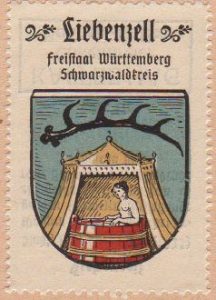
Supposedly, the factory was taken over during the war, some sites say the Allies occupied it which wouldn’t have happened until 1945, and for reasons that there are no specific details of, the company stopped producing these electrical and wireless components.
While I have no issue with the thought of a small company in the rural Black Forest area of Germany producing electrical and wireless components, but there’s absolutely no evidence of a company with the name “King” doing this in Germany. In the 1950s, there was a King Radio company outside of Kansas City that produced products for the avionics industry, but this clearly is not the same company.
I’ve scoured every research I had both online, and in books that cover the history of the German camera industry and there’s nothing. Who was the King family, and if there was a King family, who was “Mr. King”? Also, since “king” is an English word, why weren’t they called König? Unless an American relocated to Germany in the 1930s and founded his own company, it seems highly unlikely there was a family of Kings in southwestern Germany during this era.
I make this bold statement that I feel that this commonly told tale is either completely wrong, or missing a huge amount of detail as I feel I owe it to readers of this site that I did my due diligence, and I have a hard time swallowing that there isn’t more. I am sure someone knows, and perhaps I should let the rules of Murphy’s Law work in my favor and by publishing my disagreement with the story, will elicit a response from some knowledgeable reader who knows more of the story and can share it.
Edit (6/28/2022): As I had hoped, shortly after posting this review, reader Andreas Barbera came to my rescue with some new information about the King family, who they were, and how they came to make cameras. His information is in the comments section below, but for simplicity, I will copy and paste it here. Thanks Andreas!
There were indeed some people named ‘King’: Pius and Herbert King, father and son, were listed in a commercial address for Regula-Werk & Bauser GmbH from the late ‘70s. Pius founded the company in 1936, indeed to produce radio-related components, presumably for the German war effort. After the war, most of its factory equipment was “taken away” by the Allies, and after 1949 King KG turned to making cameras under the Regula brand. Sometime before the ‘70s Pius left the daily operation of the factory to both his son Herbert, and to his son-in-law Wilfried Bauser, married to one of his daughters (which is why it was renamed to ‘& Bauser’). Bauser would later also serve as a director of Concord Camera Europe, a producer of cheap cameras and photo equipment based in the US, until 1993. A certain Volkmar Kleinfeldt has a very good grasp of Regula’s history and products; he seems to be an avid collector of their gear. If you’re interested, I can contact him to see if he can give us additional details.
BTW, he mentions that the Reflex 2000 flopped because Leitz sued Regula over it (claiming it infringed their patents for the Leicaflex), and said suit was the first in a series of poor moves that sunk the company. Reportedly the project that led to the Reflex 2000 cost a million German Marks, but amounted to nothing after the lawsuit. Later, in 1984, Regula overestimated the market for disk cameras… and then they went bankrupt.
In any case, what we do know is that after the war, a company called Regula-Werk King KG would start producing flashguns and a line of cheap to moderately expensive cameras called the Regula.
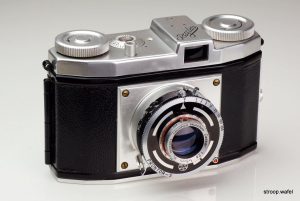
The first models were completed, possibly as early as July 1949 and shown at a local show (I don’t know what show this could be as Photokina was the de-facto German camera show, but it didn’t start until 1950). The earliest King Regulas were all simple scale focus models usually with Prontor shutters and Steinheil lenses, but versions with Compur shutters, and Enna and Staeble lenses exist as well.
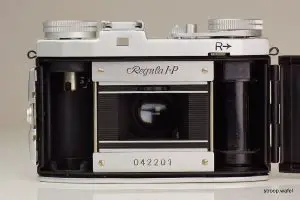
A large number of King Regula I models were produced, all with subtle differences, but an interesting characteristic of them all is that externally, they are all branded as “Regula” with the actual number engraved into a plate above the film gate, inside of the film compartment. If you come across an early King Regula and want to know what version you have, check the film compartment.
A second generation of Regulas, most of which were called the Regula II, was introduced in 1953 and had redesigned bodies that were thinner and had different top plates to make room for either an extinction meter or a rangefinder. Most (but not all) models with an extinction meter had a lower case letter ‘a’ in the model number, such as IPa, and some rangefinders were uncoupled. All second generation Regulas were lever wind compared to the first generation where only some were, and all had the film advance coupled to the shutter.
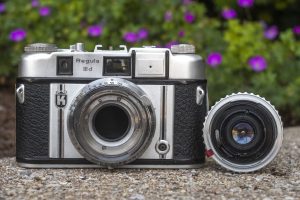
In 1958, the third generation Regulas were produced consisting of at least 14 different models, about half of which were called the Regula III. Like the first two generations, differences between third generation Regulas were often very small. One thing they all have in common was a totally redesigned and more rectangular body and top plate. The third generation Regulas are all larger and almost always have coupled rangefinders. About half of the models had uncoupled selenium exposure meters, and a couple had an interchangeable lens mount. Strangely, one model called the Regula IIa was produced which is still part of the third generation as it has the body of the other cameras in it’s generation.
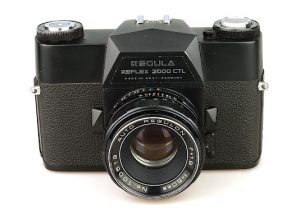
I don’t think King ever had a “hey day” but if there ever was one, it ended after the Regula III series. King would continue to produce cameras in the Regula series, but they started to lose a consistency in their design. There were pretty capable automatic rangefinders like the attractive King Regula Super Automatic but then there were extremely simple point and shoots like the Regula LKB. The company even made an SLR, the M42 mount Regula Reflex 2000 CTL, but throughout the 1970s and into the very early 80s, the company languished at the bottom of the German camera food chain, producing increasingly simple cameras, many of which were made as OEM rebadges.
Today, I think it’s fair to say there’s not many people who would call themselves a King collector, but I do believe these models are worthy of inclusion in any collection featuring well built mid century German cameras. My experience with King Regulas suggest these were well built, under the radar cameras, that for those who had an opportunity to buy one, were likely very happy with them and ones I’d definitely recommend you consider.
My Thoughts
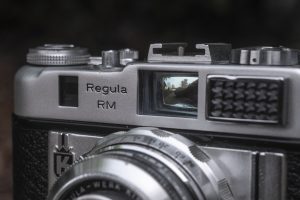
“Third time’s a charm” they say. This King Regula RM is the third III-series Regula I’ve come across after non functioning IIIbk and IIId models I acquired and was unable to get working. After handling those other two models and feeling the solid and well designed body, I persisted in my search before this nice and perfectly working RM came my way.
The King Regula RM is misleadingly large. Compared to photos seen online, I was not prepared for the heft this camera had. Having very little experience with other King models, I wasn’t sure if this would be a stamped metal, cheaply feeling camera. The camera’s overall size is neither too big, neither too small. It’s neither too heavy and neither too light. I would describe the handling of the King Regula RM as really well balanced. The curved sides of the body and rounded off edges of the top plate are comfortable in your hand and help to hide it’s size somewhat. The quality of the chrome plating on all three Regulas I have is excellent and the body covering, while not genuine leather, is deeply textured, offering comfortable grip, and isn’t peeling on this or the other two models giving the entire camera a very nice, almost luxurious appearance.
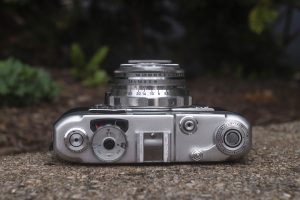
The top plate of the camera is a bit cluttered, starting with a rather small pop-up rewind knob on the left. Next is the uncoupled Bewi meter. Other metered versions of the King Regula series had Gossen meters which were also uncoupled, so their operation is similar in that you set the film speed using the dial in the center, and then while pointing the camera at your intended subject, rotate the outer ring so that the red arrow matches the white arrow, and then adjust the shutter to whatever EV reading matches the number in red shown in the small meter window. As much as I frequently complain about cameras with EV or LV scales on them, the operation of the one on the King Regula RM works quite well.
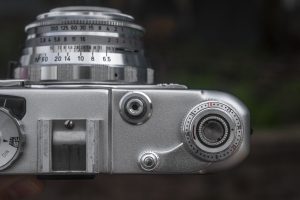
Continuing with the top plate, in the center is the accessory shoe, cable threaded shutter release, and film advance lever with combined exposure counter in the center. The counter is subtractive, showing the number of exposures remaining on the roll of film loaded in the camera. This counter must be manually reset each time a new cassette of film is loaded into the camera, to whatever number of exposures you have. Unlike the Kodak Retina series which also has a subtractive counter, the one on the Regula does not lock the shutter release when it reaches 0.
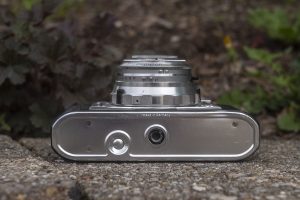
Flip the camera over and on it’s base is a centrally located 1/4″ tripod socket and rewind release button. The base plate has a recessed center section with three screws visible which possibly suggests that perhaps a piece of body covering was meant to be here, but no such covering exists on this, or any other Regula RMs I’ve seen online.
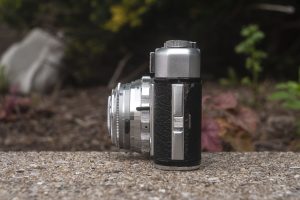
The camera’s left side is where the film door release is. Simply slide it down and the right hinged film door will swing open. The King Regula RM unfortunately lacks any strap lugs, which means that if you want to use the camera with a neck strap, you either need to have the original ever ready case, or use one that mounts to the tripod socket.
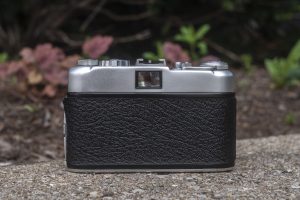
Around back there’s little to see other than the rectangular eyepiece opening for the viewfinder and a large swath of body covering on the door.
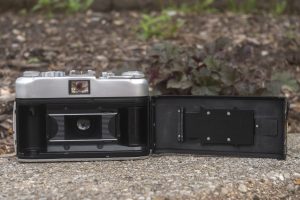
With the film door open, the film compartment is nicely detailed with no sharp edges and what appears to be a thick black matte paint on every surface except the polished film rails. Film transport is from left to right onto a single slotted and fixed take up spool. The film pressure plate is large and covered with divots to reduce friction as film transports through the camera. Four “ears” on the pressure plate rest in equivalent notches in the film gate which is there to help stabilize the pressure plate when the door is closed. Finally, a metal roller and small spring flank the pressure plate on the inside of the door, all in the name of film flatness and minimizing friction. The King Regula RM has deep channels above and below the film gate, eliminating the need for light seal material, so this camera can be shot without having to worry about replacing degraded light seals.
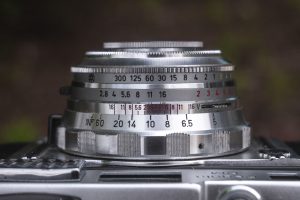
Looking down upon the Prontor-SVS shutter, we see all the same things you’d expect from a 1950s German leaf shutter rangefinder. Starting closest to the body is the focus ring. On this Regula RM, distances are indicated in feet. It is possible some exist in meters, but I have not seen any. Two small black paddles are on the opposite sides of the focus ring which helps locate and grip the ring. The total motion from minimum to infinity focus is about 140 degrees which for me, is the perfect amount, as it’s neither too short to be precise, but not so long that it requires multiple motions of the hand to go from one end of the focus range to the other.
Next up from the focus wheel is a non-movable depth of field scale engraved in red. Next to the scale is a lever for selecting M and X flash sync and a V position for the self-timer. As is the case with any camera from this era, you should not try to use the self-timer unless you are absolutely sure the camera has been serviced, as a stuck self-timer is the number one cause for shutter failure on leaf shutter cameras.
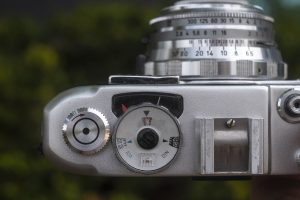
Finally, we have the coupled aperture and shutter speed rings. Off to the right of the aperture ring is an EV scale that matches the exposure values shown on the Bewi meter. Normally, the aperture and shutter speeds are locked together at a set EV number from 2 to 17. If you want to change EV numbers, a small button on the side of the aperture ring is in easy reach of your left thumb while holding the camera to your eye. Press this button in while rotating the aperture ring, and you can choose any combination of shutter speeds or aperture f/stops you wish. I was lucky that on my Regula RM, the meter appeared to be accurate, but even without an accurate meter, you can easily set any combination of shutter speed or f/stop you wish. Don’t get me wrong, I would prefer if I didn’t have to deal with EV numbers altogether, but King’s implementation of it on the Regula RM is far less frustrating than how many other manufacturers did it. I can at least appreciate that in the time this camera was sold, and for the target customer, the system likely worked really well.
Up front, there’s not much else to see on the King Regula other than the flash sync port on the front face near the 4 o’clock position around the lens. The front of the King Regula RM is nicely appointed with an attractive chrome metal and black paint logo beneath the rangefinder window and two vertical stripes on either side of the shutter.
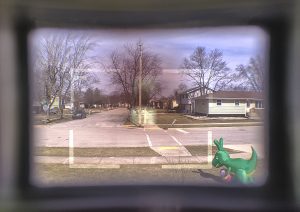
Looking through the viewfinder, the image is very large and bright. Wearing prescription glasses, I could very easily see around the projected frame lines. The main part of the viewfinder has a pink tint to it with the frame lines and rectangular rangefinder patch tinted a pale yellow. This combination, along with a clean viewfinder makes for a very contrasty image that is very easy to focus, even in low light. Beyond this however, there is nothing else to see in the viewfinder, nor do the frame lines automatic correct for parallax.
This having been my third King Regula, but the first that worked and one that I handled enough with the intent of shooting it, and I came away very impressed. Not Nikon SP or Leica M3 impressed, but for a lesser known German camera maker whose models aren’t frequently talked about, I definitely did not expect to like this camera as much as I did.
Even after writing this review, I still don’t know much about Regula-Werk King KG or who exactly the “King family” was, but whoever they were, they definitely knew how to make a really nice mid-level 35mm rangefinder. Before ever loading any film into the camera, I was very excited to see how it performed, so let’s get to it!
My Results
Feeling very confident the King Regula RM was in good working order, I loaded in a roll of my favorite film, Kodak Panatomic-X. If by some chance you haven’t read one of the many reviews I’ve done with cameras using that film, Panatomic-X is “time travel film” in that no matter how old it is, it shoots at box speed without any signs of aging. This is a slow 25-32 speed film with extremely fine grain that can show off the capabilities of the best lenses, producing images with tons of shadow detail and even contrast. For th4e second roll, I was a little less creative and went with semi-expired Fuji 200 Color.
There’s a saying that goes something like “hope for the best but expect the worst”, and in the case of a brand whose first two examples didn’t work at all, I can definitely say my hopes equaled the results.
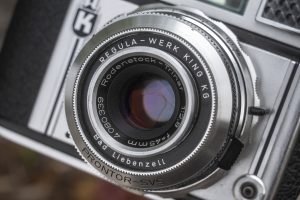
Images from the King Regula RM’s rather ordinary Rodenstock-Trinar were anything but. Sharpness was excellent in the center with only the slightest bit of softness near the edges. Most of the photos in the gallery above were shot in daylight with the sky visible and in none of the cases does vignetting creep in near the corners, suggesting excellent coverage from the triplet lens.
Although the light meter on this example did respond to light and seemed accurate, I didn’t use it, instead relying on my trusty Sunny 16, which produced properly exposed shots both in sunlight and shade. Of course the Kodak Panatomic-X looks great, but it’s nice to see such an unassuming little rangefinder making the most of this fine grained film.
I thoroughly enjoyed shooting the Regula RM as it’s size and curved edges fit perfectly in my average sized hands, the viewfinder was large and bright, allowing me to easily see the entire image while wearing prescription glasses. Contrast from the frame lines and rangefinder was extremely good, allowing me to get accurate focus on every shot. The ergonomics were excellent as well, with every control exactly where I expected it to be. Even the coupled shutter speed and aperture rings, a feature I often bemoan about frequently, didn’t slow me down much. It definitely helped that in the situations where I was shooting the camera, my lighting didn’t vary that much, but had I constantly gone from dark interiors to bright sunlight throughout the roll, I might have been more annoyed with it.
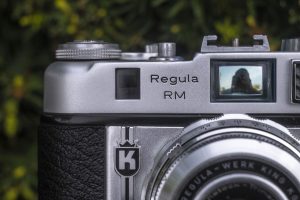
If I was forced to come up with a con for the camera, I’d have to dip into the category of nitpicks and say that I would have liked the thickness of the focus ring to be a little greater. At it’s current size, picking up the camera, it does take a second or two to fumble around and get your fingers into position. It also kinda sucks that the camera has no strap lugs, requiring you to use the ever ready case to attach a neck strap. This suckage is amplified further because other cameras in the King Regula III series, such as the interchangeable lens IIId I also have, has them. Why would the company give strap lugs to one model, and remove them on another? Who knows!
Other than that though, the King Regula RM is a winner. I can’t speak for the durability of other Regula RMs, but I can say that when found in good working condition, or after getting a good CLA, these are wonderful cameras, made by a company that isn’t the first, second, or heck, even tenth top German camera maker out there. If you were to find one of these for sale at anywhere close to a reasonable price, you owe it to yourself to give it a shot!
Related Posts You Might Enjoy
External Links
http://camera-wiki.org/wiki/Regula_III_series
https://www.35mmc.com/22/01/2021/regula-rm-mastra-v35-review/

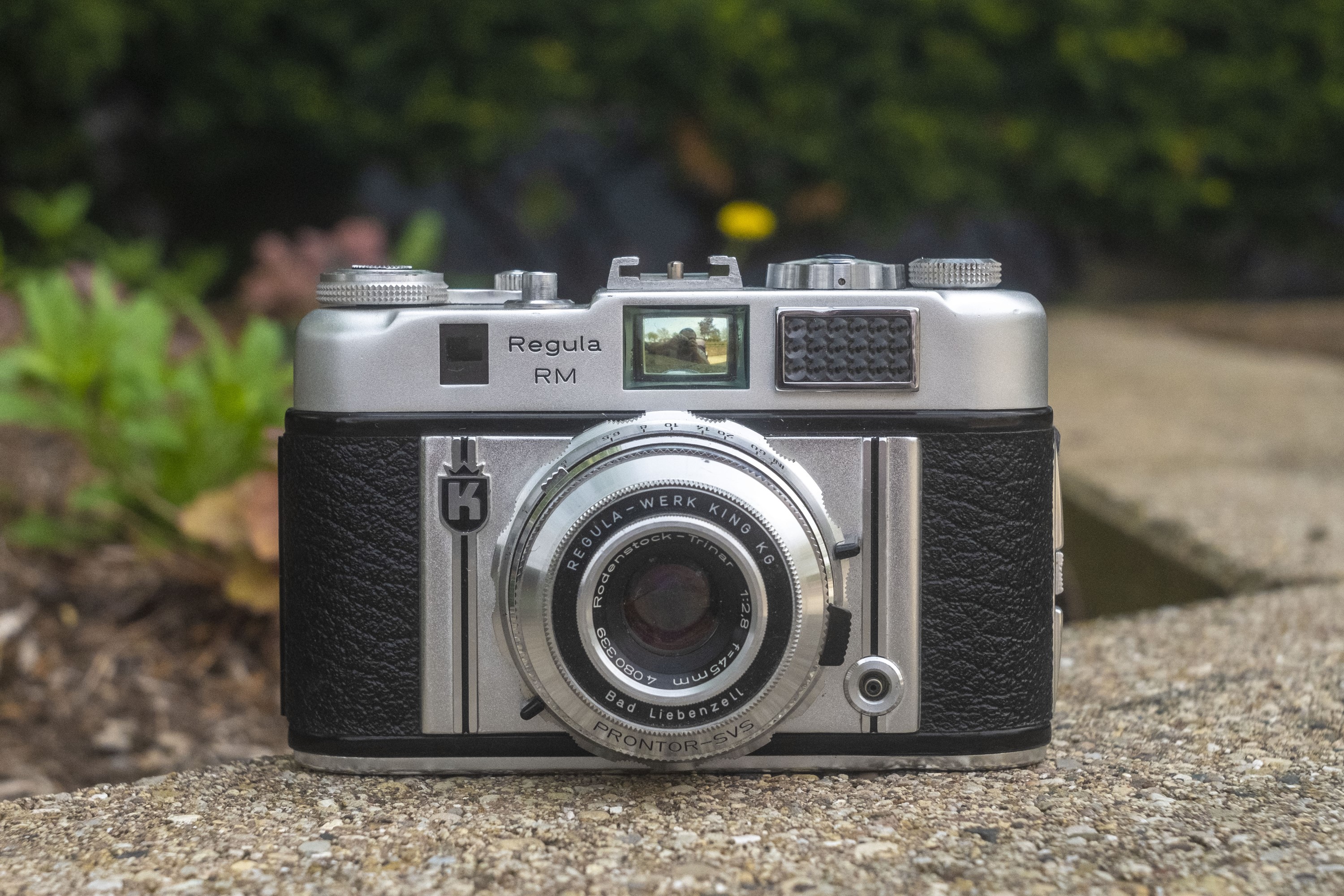
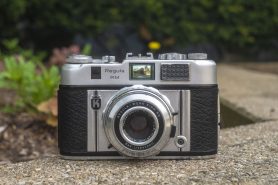
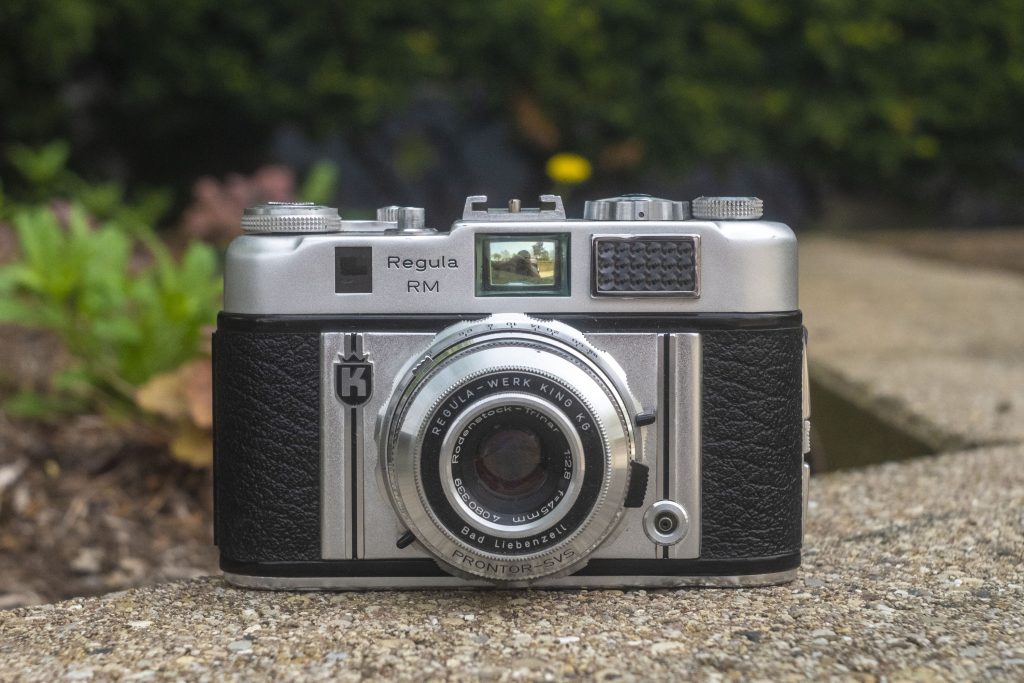


























I have owned a King Regula RM for quite a few years now and I have to say that I agree with everything that you say. When I get a “new” camera I can usually find a few things that I don’t like, but not in this case. The only difference between our two cameras is that mine has an f2.8 Zeiss Tessar lens. Don’t tell every one about these or they will all want one!
Glad I’ve found another fan. I have really enjoyed shooting this camera every time I’ve used it. I also love the weight, size, shape, and ergonomics. Everything falls into place and the fit is perfect for me! I’ll stop raving about them now, so as not to further drive up the prices too high!
This post brings back many memories. My first 35mm camera was a cheap electronic Regula my dad bought me from K-Mart. I think it cost around $40, which was a ton of money in the early 70’s. I can’t remember the name of the camera, but I think it might have had Magic in the name. It was scale focus with auto exposure. I learned how to develop black and white film myself with a GAF stir tank, and was making enlargements with a slide projector. That Regula didn’t last that long, since it wasn’t very durable, and I moved on to an Argus Cosina STL1000.
My mom worked across the street from a camera store, and I got lots of my film and darkroom supplies from them. I was in there one day as a teenager in the mid 70’s, and noticed a used Regula in their display cabinet. It was a Regula IIId, and it looked pretty cool. it was much nicer than the cheap one I had before. I asked how much they were selling it for, and he told me I could have it for $5. I couldn’t believe it, since basically he was just giving it to me. It was actually a really nice camera, and a little more advanced that the RM here. It had an interchangeable 50mm f2.8 lens (Enna, I think), a Gossen meter that worked, and a coupled rangefinder. Everything worked great. The only thing that was suspect was the screw that held down the film advance lever. It wasn’t the original screw, and it tended to loosen up after a while. It wasn’t really a problem, but it did need to be tightened down from time to time. The images were as good as any other camera, and it was my favourite for a few years.
In the early 80’s I gave the camera to one of my employees at the photolab I managed. I hope it’s still working. I’ve kept my eye out for another one, and I’ve seen a couple, but the sellers wanted more than I was willing to pay for nostalgia.
On a side note, I wrote to Regula in Germany about a question I had about one of my cameras. I can’t remember if it was about my first one, or about the IIId, This would have been some time in the 70’s. I got a very nice letter back from someone at Regula in Germany, so they were still actively in business at the time. They were still making flash units well into the 80’s from what I remember.
Hi Mike: King does seem to exist as a German word. See https://dictionary.cambridge.org/dictionary/german-english/king, which explains that it means a person that is particularly admired.
If so, it also could be a proper name, and would not be so strange as a company name in any event.
Geert
Good review, Mike, suggesting another camera that’d suit those of us who prefer heavy and large equipment. Based on experience, I’d avoid the “Regula Sprinty”, a later-generation cheesy camera with more plastic and less reliability than the earlier Regulas.
Thanks Roger! I think I am good with other Regula cameras, other than the Regula Reflex 2000 SLR. I would be interested in checking that one someday! Noted about the Sprinty! 🙂
So, since I know German fairly well, I decided to do some digging. There were indeed some people named ‘King’: Pius and Herbert King, father and son, were listed in a commercial address for Regula-Werk & Bauser GmbH from the late ‘70s. Pius founded the company in 1936, indeed to produce radio-related components, presumably for the German war effort. After the war, most of its factory equipment was “taken away” by the Allies, and after 1949 King KG turned to making cameras under the Regula brand. Sometime before the ‘70s Pius left the daily operation of the factory to both his son Herbert, and to his son-in-law Wilfried Bauser, married to one of his daughters (which is why it was renamed to ‘& Bauser’). Bauser would later also serve as a director of Concord Camera Europe, a producer of cheap cameras and photo equipment based in the US, until 1993. A certain Volkmar Kleinfeldt has a very good grasp of Regula’s history and products; he seems to be an avid collector of their gear. If you’re interested, I can contact him to see if he can give us additional details.
BTW, he mentions that the Reflex 2000 flopped because Leitz sued Regula over it (claiming it infringed their patents for the Leicaflex), and said suit was the first in a series of poor moves that sunk the company. Reportedly the project that led to the Reflex 2000 cost a million German Marks, but amounted to nothing after the lawsuit. Later, in 1984, Regula overestimated the market for disk cameras… and then they went bankrupt.
Andreas, this is terrific. You’ve managed to include more info about the history of King in this one comment than anywhere else I’ve found online! I will revise the review and include your comments! Thank you!
Also interesting about the Reflex 2000. Now I want one even more! 🙂